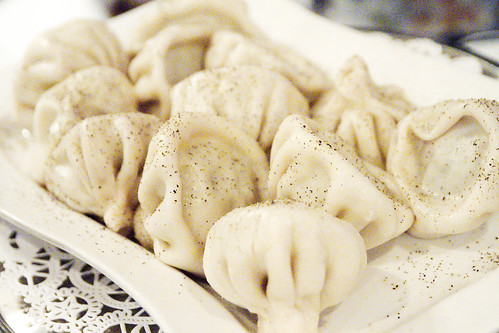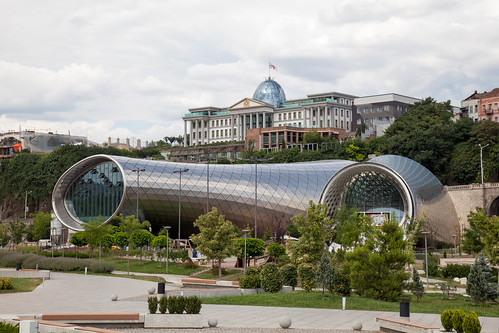Ines introduced me to soup dumplings. Specifically, she introduced me to Georgian soup dumplings, called khinkali, which are richer, meatier and sturdier than their Chinese cousins and, in my opinion, more delicious. Unlike thin xiao long bao, you grab khinkali with your hands and douse them with pepper, before biting a hole to slurp up the rich, meaty broth. They’re big and satisfying and easy to fall in love with.
Needing to make up for years of missed khinkali eating, I devoured them London, found them in Budapest and unearthed them in Kiev. New York, I figured, would continue the romance. After all, this is a city where you could easily embrace a dumpling-only diet without hopping on a subway. Unfortunately, apart from a smattering of restaurants stranded out in Sheepshead Bay and Brighton Beach, Georgian cuisine is woefully underrepresented. There are, however, a few places that serve them. At Apani you can order them by the piece to takeaway. If you prefer to sit down there’s Mtskheta. Not that I can vouch for either of these places—I haven’t made it out there. When the khinkali cravings strike, I make my own.
But let’s back up a bit. How did my friend learn about Georgian soup dumplings? Ines’s longtime boyfriend is from Georgia and he introduced her to them. In Paris, her hometown, she gets her khinkali fix at the city’s Georgian restaurants. France, and Paris in particular, has one of the highest percentages of Georgian immigrants in Europe—in 2013, there were approximately 10,000 living there. In Europe, only Turkey, Ukraine, Greece and the UK have more (admittedly, approximately 500,000 Georgians live in the United States,). When Ines wants khinkali, she doesn’t need to convince her boyfriend to make them. She just books a meal at one of the city’s smattering of Georgian restaurants and shows up with some friends to feast.
Although the precise ingredients vary across the country—Georgia is, after all, huge—the recipe for khinkali follows the basic dumpling formula: wheat-based wrapper (no egg) and a meat-y filling with a smattering of spices. Fillings range from lamb with a pinch of cumin to beef and pork with cilantro, chili and onion. The latter version is particularly popular in Tbilisi where they are called kalakuri, or city style. You can also find vegetarian versions with potatoes, mushrooms and cheese.
But you won’t know what’s inside until you try. Part of what makes khinkali khinkali and not pelmeni or xiao long bao is their distinctive top knot. This piece of pinched dough is called the kudi, hat, or k’uch’i, stomach. Whether or not this bit should be eaten and why is a hotly debated topic. Some argue that it’s undercooked, while others contend that not eating the top prevents you from overeating these delicious dumplings as you can track how many you’ve had. Personally, I’ll often toss back even this bit, the comparatively bland doughy chew serving as an antidote to the rich meaty filling.
Yet I find myself languishing in a soup dumpling-less world until one weekend in March when I decided to break out my rolling pin and make them myself. I was intimidated. My dumplings are gnocchi and ravioli or ordered out from the local Chinese restaurants. How could I make this recipe that was the domain of Georgian restaurants? Did people even make them at home? Turns out the answer is yes. And so, I decided, I could take on the mantle of preparing these doughy little beasts myself.
Preparing them is relatively simple. You start with the wrapper, a simple combination of flour and water, kneaded until smooth and left to rest for a bit. While that’s happening you make your meat filling, which is no more complicated than tossing together a meatball. Combine the meat of your choosing with some spices—I chose lamb because it’s my favorite and threw in some chili, parsley and pepper for good measure. The hardest bit is rolling out the wrappers, even bundling them up is easy as the top knot requires no more than a generous pinch.
As dumplings become a trend against a rise of populist sentiment, Georgian dumplings seem uniquely poised to help Americans better understand the nuances of Russian-inflected cultures. After the conflicts with Russia in 2008, Georgia has stayed out of the minds of most Americans. But the region has much to offer us, even if we never make a trip to Tbilisi or Batumi. Georgia boasts one of the world’s most ancient wine cultures, they have a rich folklore tradition—to say nothing of their amazing food. Georgian soup dumplings deserve a wider audience and you should make them and invite everyone over to discover the delights of khinkali.

